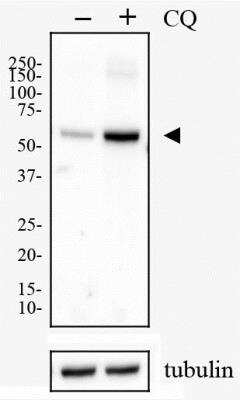SQSTM1 Rabbit Polyclonal Antibody
Frequently bought together (3)
Recombinant protein of human sequestosome 1 (SQSTM1), transcript variant 1
USD 823.00
Transient overexpression lysate of sequestosome 1 (SQSTM1), transcript variant 1
USD 396.00
Other products for "SQSTM1"
Specifications
| Product Data | |
| Applications | WB |
| Recommended Dilution | Simple Western: 1:25, Immunocytochemistry/ Immunofluorescence: 1:50, Western Blot: 1:2000, Knockout Validated, Flow Cytometry |
| Reactivities | Human, Mouse, Rat |
| Host | Rabbit |
| Clonality | Polyclonal |
| Immunogen | A synthetic peptide made to an internal region of the human p62/SQSTM1 protein (within residues 400-450). [Swiss-Prot Q13501] |
| Formulation | PBS, 0.05% Sodium Azide. Store at 4C short term. Aliquot and store at -20C long term. Avoid freeze-thaw cycles. |
| Concentration | lot specific |
| Purification | Immunogen affinity purified |
| Conjugation | Unconjugated |
| Storage | Store at -20°C as received. |
| Stability | Stable for 12 months from date of receipt. |
| Predicted Protein Size | 47 kDa |
| Gene Name | sequestosome 1 |
| Database Link | |
| Background | p62/SQSTM1 (sequestosome 1) is ubiquitously-expressed cytoplasmic/adapter protein conserved in vertebrates and it can be induced by proteasomal inhibitor PSI, PGJ2/prostaglandin J2 as well as phorbol 12-myristate 13-acetate (PMA). SQSTM1 has the ability of ubiquitin binding as well as regulating NFkB1 activation by TNF-alpha, NGF (nerve growth factor) and interleukin-1. SQSTM1 acts as an adapter that mediates the interaction between TRAF6 and CYLD, and SQSTM1-TRAF6 interaction leads to K63-linked polyubiquitination of TRAF6 followed by subsequent activation of NFkB pathway. SQSTM1 plays a role in TITIN/TTN downstream signaling in muscle cells and regulate signaling cascades through ubiquitination. SQSTM1 is essential both for formation and autophagic degradation of polyubiquitin-containing bodies which are known as aggresome-like induced structures (ALIS) and SQSTM1 connects ALIS to the autophagic machinery via direct interaction with MAP1 LC3 family members. Moreover, while autophagy modulates SQSTM1 protein levels, SQSTM1 suppresses autophagy via activation of mTORC1. SQSTM1 interacts with KEAP1, which is a cytoplasmic inhibitor of NRF2, a key transcription factor involved in cellular responses to oxidative stress. SQSTM1 functions as a signaling hub for various signal transduction pathways, apoptosis, cell differentiation, apoptosis, immune response, regulation of K+ channels and Nrf2 activation, and its dysregulation is associated with Paget disease of bone and tumorigenesis. |
| Synonyms | A170; OSIL; p60; p62; p62B; PDB3; ZIP3 |
| Note | This p62/SQSTM1 antibody is useful for Immunocytochemistry/Immunofluorescence and Western blot, where a band is seen at ~47 kDa. |
| Reference Data | |
| Protein Families | Druggable Genome, Transcription Factors |
Documents
| Product Manuals |
| FAQs |
| SDS |
{0} Product Review(s)
0 Product Review(s)
Submit review
Be the first one to submit a review
Product Citations
*Delivery time may vary from web posted schedule. Occasional delays may occur due to unforeseen
complexities in the preparation of your product. International customers may expect an additional 1-2 weeks
in shipping.






























































































































































































































































 Germany
Germany
 Japan
Japan
 United Kingdom
United Kingdom
 China
China





